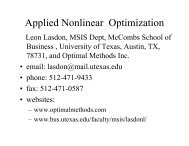[PDF] ALIO Back Matter
[PDF] ALIO Back Matter
[PDF] ALIO Back Matter
Create successful ePaper yourself
Turn your PDF publications into a flip-book with our unique Google optimized e-Paper software.
MC05<br />
2 - A Cutting-plane Algorithm for the Slitherlink Puzzle<br />
Tony Hürlimann, Research Fellow, University of Fribourg, Perolles<br />
90, Fribourg, CH-1700, Switzerland, tony.huerlimann@unifr.ch<br />
This document presents a mathematical modeling approach to solve difficult<br />
Slitherlink puzzles. We show how such puzzles can be formulated as MIP models<br />
which then are solved using a Branch-and-Cut method. The method solves the<br />
puzzle by adding repeatedly valid integer cuts to a MIP model. It is show that this<br />
method is very efficient in solving difficult puzzles. An complete implementation in<br />
a mathematical modeling language is also presented.<br />
3 - Heuristics for Mixed Integer Nonlinear Programs and Their<br />
Implementation in Bonmin<br />
João Goncalves, IBM Research, 1101 Kitchawan Road, Yorktown<br />
Heights, NY, United States of America, jpgoncal@us.ibm.com,<br />
Pierre Bonami<br />
We show how several heuristics for finding feasible solutions of Mixed Integer<br />
Linear programs can be adapted to Mixed Integer Nonlinear programs (MINLPs) and<br />
describe their implementation in the open source solver Bonmin. We present<br />
computational results on a set of convex MINLP instances and show that they can<br />
help the branch-and-bound algorithm reduce the computational time to solve those<br />
instances.<br />
■ MC05<br />
Velez Sarfield- Second Floor<br />
Case Studies in Multiple Criteria Decision Aiding<br />
Cluster: Multicriteria Analysis and Optimization<br />
Invited Session<br />
Chair: Luiz F. Autran M. Gomes, Ibmec Business School, Av. Presidente<br />
Wilson, 118, Oficina 1110, Rio de Janeiro, Brazil, autran@ibmecrj.br<br />
1 - Using SMAA to Assess the Cost-effectiveness of Healthcare<br />
Interventions: A Case Study<br />
Dowe Postmus, University Medical Center Groningen, PO Pox<br />
30.001, Groningen, 9700 RB, Netherlands, d.postmus@epi.umcg.nl,<br />
Tommi Tervonen, Hans Hillege, Erik Buskens<br />
In cost-effectiveness analysis (CEA), competing healthcare interventions are<br />
evaluated in terms of their costs and effects. So-called cost effectiveness acceptability<br />
curves offer a useful way of representing decision uncertainty when there are two<br />
alternatives, but their interpretation becomes less clear when three or more<br />
alternatives are being considered. I will use a case study in heart failure to show<br />
how SMAA can be used as an improved method for representing decision<br />
uncertainty in CEA.<br />
2 - A Case Study on Municipal Economic Comparison in<br />
Sinaloa, Mexico<br />
Juan Carlos Leyva López, Universidad de Occidente,<br />
Blvd. Lola Beltran y Blvd Rolando Arjona, Culiacan, Mexico,<br />
jleyva@culiacan.udo.mx, Katia Paez, Edmundo Resenos<br />
In this paper, we present a real case study dealing with the comparison of municipal<br />
economic situations. To do so, we employ a multicriteria model to compare basic<br />
economic variables comprehensively. We present the problem situation and an<br />
appropriate problem formulation. Moreover, a detailed version of the multicriteria<br />
evaluation model is also presented.<br />
3 - The MACBETH Approach to Deal with Social Responsibility<br />
Concerns in Development Cooperation<br />
Ramiro Sanchez-Lopez, Researcher, CEG-IST, Technical University of<br />
Lisbon, c/ Doctor Esquerdo 126, Madrid, 28007, Spain,<br />
ramirosanchezl@gmail.com, Carlos Bana e Costa<br />
One topical question in the field of development cooperation how to appraise<br />
projects and programs from the perspective of social responsibility, articulating<br />
effectively what is known as cross-cutting issues. The difficulty found on the design<br />
of evaluation and monitoring models lies on the intangible and qualitative nature of<br />
those issues. We describe how the MACBETH socio-technical multicriteria approach<br />
was used for this purpose, in a rural development Programme in Bolivia.<br />
4 - Electronic Payment – Alternatives Evaluation using a Multicriteria<br />
Support Decision<br />
Carlos Gomes, Ibmec Business School, Rio de Janeiro, Brazil,<br />
cgomes@ibmecrj.br, Thiago Qualharini<br />
This paper presents some of the electronic payments available in Brazil and in the<br />
world. This study includes some of the new technologies and concepts of current<br />
means of payment in particular the credit and debit cards. The results allowed<br />
ordering technological alternatives that can attend the expanded use of credit card<br />
market, and the world. Three technological alternatives were compared by fourteen<br />
criteria. The work is based on a real case study in Brazil carried on through MCDA<br />
Thor, a decision support system that implements algorithms based on the concepts<br />
of electre family developed in Brazil. Fuzzy Set and Rough Set was used to quantify<br />
the imprecision and uncertainty. The work is based on a real case study in Brazil.<br />
<strong>ALIO</strong> / INFORMS International – 2010<br />
62<br />
■ MC06<br />
Aula 352- Third Floor<br />
Financial Engineering<br />
Contributed Session<br />
Chair: Suleyman Ozekici, Professor, Koç University, Department of<br />
Industrial Engineering, Istanbul, Turkey, sozekici@ku.edu.tr<br />
1 - Supply Chain Configuration Under Uncertainty- An Approach using<br />
Real Options<br />
Victor Jiménez, Universidad del Valle, Calle 13 # 100-00, Cali,<br />
Colombia, victorj@colombia.com, Diego Fernando Manotas<br />
One of the most important decisions in logistics is the configuration of the supply<br />
network, which mainly considers variables related to the flow of products, but those<br />
should also be considered depending on the market and can influence a large scale<br />
in the expected results. This article presents a methodology for network design in<br />
supply chains, based on real options theory including the uncertainty associated<br />
with variables such as demand, exchange rates and interest rates.<br />
2 - Optimal Portfolio Allocations with Hedge Funds<br />
Jerome Detemple, Professor, Boston University, 595 Commonwealth<br />
Avenue, Boston, MA, 02215, United States of America,<br />
detemple@bu.edu, Marcel Rindisbacher, Rene Garcia<br />
This paper analyzes optimal investment decisions, in the presence of non-redundant<br />
hedge funds, for investors with constant relative risk aversion. Factor regression<br />
models with option-like risk factors and no-arbitrage principles are used to identify<br />
and estimate the market price of hedge fund risk. The paper examines the optimal<br />
portfolio behavior and the impact of timing and selection abilities.<br />
3 - Can Oil Prices Help Estimate Commodity Futures Prices?<br />
The Cases of Copper and Silver<br />
Gonzalo Cortazar, Pontificia Universidad Católica de Chile,<br />
Vicuna Mackenna 4860, Santiago, Chile, gcortaza@ing.puc.cl,<br />
Francisco Eterovic<br />
We use prices of long term oil futures contracts to estimate copper and silver prices.<br />
We show that the Cortazar et al (2008) multi-commodity model applied to oilcopper<br />
and oil-silver which have low correlation seems not to be effective. We then<br />
propose a modified multi-commodity model that uses the non-stationary long term<br />
process of oil to help estimate long term copper and silver futures prices, achieving a<br />
much better fit than using available individual or multi-commodity models.<br />
4 - Monte Carlo Simulation as an Aid to Determining the Value at Risk:<br />
Applications to a Peruvian Stock Market’s Portfolio<br />
Christian Cornejo, Pontificia Universidad Católica Del Perú, Av.<br />
Universitaria 1801. San Miguel, Lima, Peru, cscornejo@pucp.edu.pe,<br />
Eduardo Carbajal<br />
The applied study of risk factors define a portfolio, and from a representative sample<br />
of these, specifies its randomized to outline, from a large number of tests, a response<br />
to how they affect the portfolio.<br />
5 - Portfolio Selection with Random Risk Tolerance<br />
Suleyman Ozekici, Professor, Koç University, Department of<br />
Industrial Engineering, Istanbul, Turkey, sozekici@ku.edu.tr,<br />
Turan Bulmus<br />
We analyze a single-period portfolio selection problem where the investor<br />
maximizes the expected utility of the terminal wealth. The utility function is<br />
exponential, but the risk tolerance is random. It is well-known that an investor is<br />
memoryless in wealth for exponential utility functions with a known risk tolerance.<br />
However, we show that this is no longer true if risk tolerance is random and obtain<br />
characterizations on the structure of the optimal policy.<br />
■ MC07<br />
Aula 353- Third Floor<br />
Inventory Management<br />
Contributed Session<br />
Chair: Joaquin Sicilia, Professor, Universidad de La Laguna, Fac. de<br />
Matematicas, Dpto. Estadistica, La Laguna, 38271, Spain, jsicilia@ull.es<br />
1 - An Algorithm Based on Linear Programming to Solve the<br />
Constrained Joint Replenishment Problem<br />
Jimmy Alexander Carvajal Beltrán, Universidad De Los Andes,<br />
Carrera 1 N∞ 18A 10 oficina ml-752, Bogotá, Colombia,<br />
ja.carvajal911@uniandes.edu.co, Ciro Alberto Amaya<br />
This paper examines the joint replenishment problem under deterministic demand<br />
and resource constraints(C-JRP). This problem is solved using a method based on<br />
linear programming; a comparative analysis highlighting the efficiency of the<br />
proposed process in relation to existing algorithms in literature.


![[PDF] ALIO Back Matter](https://img.yumpu.com/17932960/42/500x640/pdf-alio-back-matter.jpg)
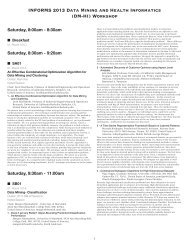
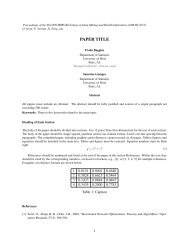
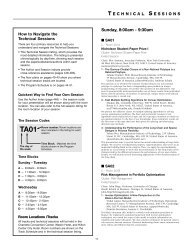
![[PDF] Charlotte Back Matter](https://img.yumpu.com/17933057/1/190x245/pdf-charlotte-back-matter.jpg?quality=85)

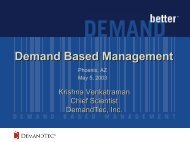
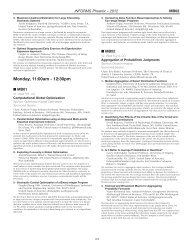
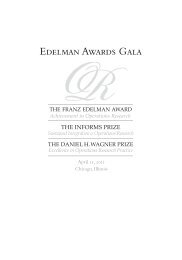
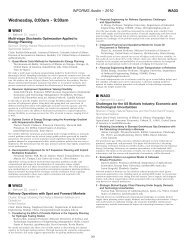
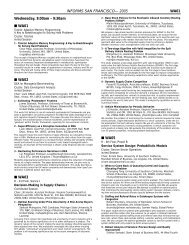
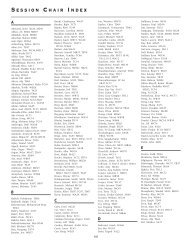
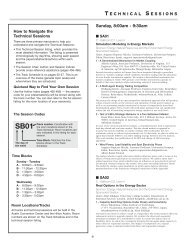
![[PDF] Monday, 8:00am - 9:30am](https://img.yumpu.com/17932954/1/190x245/pdf-monday-800am-930am.jpg?quality=85)
